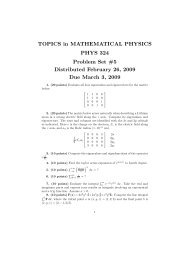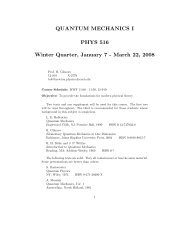Homework 2 solutions
Homework 2 solutions
Homework 2 solutions
Create successful ePaper yourself
Turn your PDF publications into a flip-book with our unique Google optimized e-Paper software.
<strong>Homework</strong> 2 <strong>solutions</strong><br />
Problem 10. A 50.0 g super-ball traveling at 25.0 m/s bounces off a brick wall and rebounds at 22.0 m/s. A high-speed<br />
camera records this event. If the ball is in contact with the wall for 3.50 ms, what is the magnitude of the average acceleration<br />
of the ball during this time interval. (Note: 1 ms = 10 −3 s.)<br />
Pick a coordinate system (e.g. rebound direction is positive). Then v 0 = −25.0 m/s and v 1 = 22.0 m/s.<br />
Problem 16. Draw motion diagrams...<br />
a ≡ ∆v<br />
∆t = v 1 − v 0 [22.0 − (−25.0)][m/s]<br />
=<br />
∆t 3.50 ms · 1s = 47.0m/s<br />
10 3 ms 3.5 · 10 −3 s = 13400 m/s2 (1)<br />
Look at Figure 2.11 on page 50 of the text. For question parts (e) and (f), draw figures (b) and (c) respectively but with<br />
the x-axis reversed.<br />
Note the different spacing in the figure because the ‘strobe’ is going off at a constant frequency (same time between<br />
pictures). If you didn’t vary the spacing when the velocity changed, you’d need to point out somewhere that your time<br />
intervals were not constant.<br />
I also accepted plots of velocity or position vs time.<br />
Problem 40. A woman is reported to have fallen 144 ft from the 17th floor of a building, landing on a metal ventilator box<br />
that she crushed to a depth of 18.0 in. She suffered only minor injuries. Ignoring air resistance, calculate (a) the speed of<br />
the woman just before she collided with the box and (b) her average acceleration while in contact with the box. (c) Modeling<br />
her acceleration as constant, calculate the time interval it took to crush the box.<br />
(a)<br />
First deal with the portion from the top (point P 0 ) to the point of collision with the box (point P 1 ). Pick a coordinate<br />
system pointing down, with x 0 = 0 m. Converting the distance into meters:<br />
So<br />
P 0 P 1<br />
a 9.8 m/s 2<br />
v 0 m/s ?<br />
x 0 m 43.9 m<br />
t 0 s ?<br />
We want v 1 and we don’t know t 1 so we use<br />
x 1 = 144 ft ·<br />
1 m<br />
= 43.9 m (2)<br />
3.28 ft<br />
v 2 1 = v 2 0 + 2a∆x 01 (3)<br />
v 1 = √ 2a(x 1 − x 0 ) = √ 2 · 9.8 m/s · 43.9 m = 29.3 m/s (4)<br />
Some people wanted to leave ∆x in ft, and this works if you also use a in ft/s 2 . You run into trouble if you use ft for one<br />
and m for the other...<br />
(b)<br />
Converting the change in x over the box into m we have<br />
∆x 12 = 18in ·<br />
Calling the point just after she crushed the box P 2 , we have<br />
(c)<br />
1 ft<br />
12 in · 1 m<br />
= 0.457 m (5)<br />
3.28 m<br />
v 2 2 = v 2 1 + 2a 12 ∆x 12 (6)<br />
a 12 = −v2 1 −(29.3 m/s)2<br />
=<br />
2∆x 12 2 · 0.457 m = −941 m/s2 (7)<br />
v 2 = a 12 t 12 + v 1 (8)<br />
−29.3 m/s<br />
t 12 = −v 1 /a 12 =<br />
2<br />
= 31.2 ms<br />
−941 m/s<br />
(9)<br />
1
Problem 49. Setting a world record in a 100 m race, Maggie and Judy cross the finish line in a dead heat, both taking<br />
10.2 s. Accelerating uniformly, Maggie took 2.00 s and Judy 3.00 s to attain maximum speed, which they maintained for the<br />
rest of the race. (a) What was the acceleration of each sprinter? (b) What were their respective maximum speeds? (c) Which<br />
sprinter was ahead at the 6.00 s mark and by how much?<br />
(a,b)<br />
Consider Maggie first. Let P 0 be the Maggie leaving the starting line, P 1 be Maggie finishing her acceleration phase, and<br />
P 2 be Maggie finishing the race.<br />
P 0 P 1 P 2<br />
a ? 0 m/s 2<br />
v 0 m/s ?<br />
x 0 m ? 100 m<br />
t 0 s 2.00 s 10.2 s<br />
Using the 2nd equation from Table 2.2 on page 53 on the first leg:<br />
And again on the second leg:<br />
x 1 = 0.5(v 0 + v 1 )t 1 + x 0 = 0.5v 1 t 1 (10)<br />
x 2 = 0.5(v 2 + v 1 )(t 2 − t 1 ) + x 1 = 0.5(v 1 + v 1 )(t 2 − t 1 ) + 0.5v 1 t 1 = v 1 (t 2 − t 1 + 0.5t 1 ) = v 1 (t 2 − 0.5t 1 ) (11)<br />
x 2<br />
100 m<br />
v 1 = =<br />
= 10.9 m/s<br />
t 2 − 0.5t 1 10.2 s − 0.5 · 2.00 s<br />
(12)<br />
Which is the answer for Maggie in part (b). So<br />
Which answers Maggie in part (a).<br />
Applying the formulas to Judy,<br />
(c)<br />
v 1 =<br />
v 1 = a 1 2t 1 + v 0 (13)<br />
a 1 2 = v 1 /t 1 =<br />
x 2<br />
t 2 − 0.5t 1<br />
=<br />
a 1 2 = v 1 /t 1 =<br />
10.9 m/s<br />
2.00 s<br />
= 5.43 m/s 2 (14)<br />
100 m<br />
= 11.5 m/s (15)<br />
10.2 s − 0.5 · 3.00 s<br />
11.5 m/s<br />
3.00 s<br />
= 3.83 m/s 2 (16)<br />
x M (t) = v M1 (t − t M1 ) + x M1 (17)<br />
x J (t) = v J1 (t − t J1 ) + x J1 (18)<br />
∆x = x M (6 s) − x J (6 s) = 10.9 m/s · 4.00 s + 0.5 · 10.9 m/s · 2.00 s − 11.5 m/s · 3.00 s − 0.5 · 11.5 m/s · 3.00 s = 2.62 m<br />
(19)<br />
2


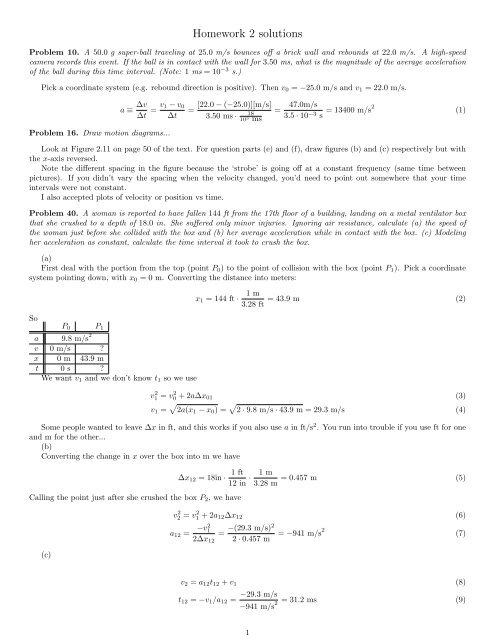
![[PDF] Problem Set #1](https://img.yumpu.com/51299607/1/190x245/pdf-problem-set-1.jpg?quality=85)
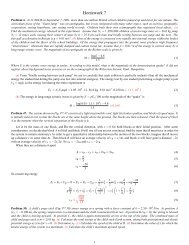
![[PDF] Problem Set #3](https://img.yumpu.com/50150452/1/184x260/pdf-problem-set-3.jpg?quality=85)
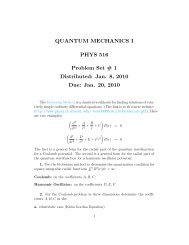
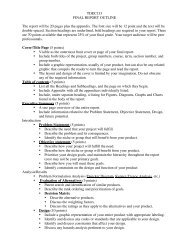
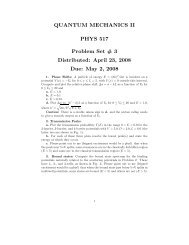
![[PDF] Problem Set #2](https://img.yumpu.com/45468456/1/184x260/pdf-problem-set-2.jpg?quality=85)
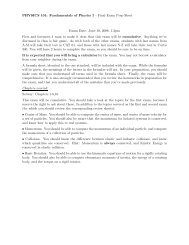
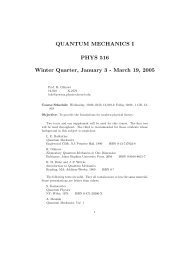
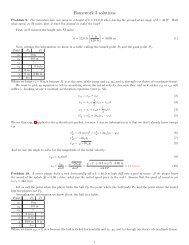
![[PDF] Xiang Liu: Fourier Transform Interferometer](https://img.yumpu.com/39562390/1/190x245/pdf-xiang-liu-fourier-transform-interferometer.jpg?quality=85)
![[PDF] Midterm Template](https://img.yumpu.com/39562028/1/184x260/pdf-midterm-template.jpg?quality=85)

